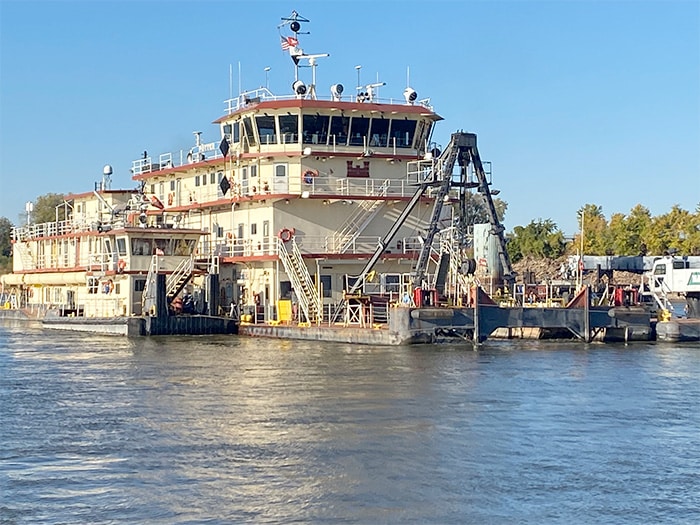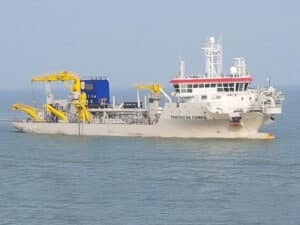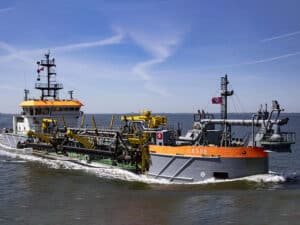
Veteran USACE dredge Potter wraps up busy season
Written by Marine Log Staff
The St. Louis District’s dredge Potter assisted by the Kimmswick worked 24/7 through the 2022-23 dredging season on the Mississippi River. The Potter, built in 1932, is a dustpan dredge. The Kimmswick, commissioned in 2006, assists the dredge with pipeline movements. [USACE photo by Janet Meredith]
Mississippi River drought conditions kept the St. Louis Engineer District’s veteran dustpan dredge Potter, originally built in 1932, busy throughout its 2022-23 season, which ended on February 1, 2023.
To maintain the congressionally mandated nine-foot-deep, 300-foot-wide navigation channel and overcome the challenges from the widespread drought, and prolonged extreme low water, dredging operations moved nine million cubic yards of material, at 70 different locations along 300 miles of the St. Louis District.
Normally, an average year results in three to four million cubic yards of material being moved in the St. Louis District by two dredges. This past season, seven dredging units — dustpan, cutterhead and mechanical — were working throughout the St. Louis District area of responsibility. Two other units, for a total of nine, supported Mississippi Valley Division efforts on the Mississippi River.
In anticipation of the drought, the St. Louis District Dredging Program Manager, Lance Engle, implemented advanced measures – bringing in additional assets ahead of the forecasted lows – to maintain the congressionally authorized channel. As the extreme low water persisted month after month, closely monitored surveys were consistently reviewed in conjunction with the forecast and input from industry to determine the order and coordination of work and additional assets needed. The ability of the team to present a common operating picture through meetings, phone calls and the Navigation Conditions Status Report enabled the safe planning and shipment of waterborne commerce in support of the nation’s economy.
For reference, it would take more than 2,700 Olympic-size swimming pools to contain the nine million cubic yards of dredge material removed from the riverbed this year, compared with just 1,000 Olympic-size swimming pools in a normal season.
The St. Louis gauge steadily declined from a level of +29.77 feet on May 7, 2022, to -3.87 feet on December 25, 2022. Meanwhile, the St. Louis District’s water control office worked behind the scenes to continuously monitor river levels and make gate adjustments on the district’s reservoirs and dams. Water managers constantly collected water data while monitoring numerous hydrological and meteorological factors to forecast river conditions. Strategic measures were taken when the river dropped to its lowest level releasing water from the Melvin Price to allow for additional water to avoid dropping to -6.8 feet.
“As we continue to get more rain and snowmelt season begins, the USACE Water Control division will continue to monitor river stages to provide a safe and reliable navigation channel,” said Joan Stemler, chief, Water Control Operations. When we experience historic lows or seasonal highs, it’s always a challenge to keep commerce moving, but by constant communication, collaboration, and commitment we can increase preparedness and anticipate what conditions might arise in the future.”
Day in and day out, the dredge crews kept their focus on the important mission at hand as they constantly synchronized assets and coordinated efforts to prioritize and address dredging locations before they became an issue. This proactive approach improved their operational proficiency in a highly complex ever-changing environment.
“Without navigation on the Mississippi River, there would be significant impacts to our supply chain, economy, and national security,” noted Lou Dell’Orco, chief of operations and readiness.
Throughout this roller-coaster navigation season, the St. Louis District remained proud of the resiliency of the 53-members of the crew of the dredge Potter, their unity of teamwork and the partnerships with other agencies and industry.
According to Dell’Orco, “Advanced measures taken by the Dredging Product Deliver Team, dredges provided by sister districts, strategic management of low water conditions and the common operating picture that was maintained by the Corps, U.S. Coast Guard Sector Upper Mississippi River, the River Industry Action Committee and local partners resulted in maintaining the nine-foot shipping channel during extreme low water.”
“Above all, the master and crew of the dredge Potter excelled in the delivery of the dredging mission. Their passion and pride in operating and maintaining the 90-year-old vessel was critical to the success of the mission. The next steps in the process are to conduct off season maintenance on the Dredge Potter and document lessons learned and best practices from this event to refine and improve future actions related to low water,” Dell’Orco concluded.




